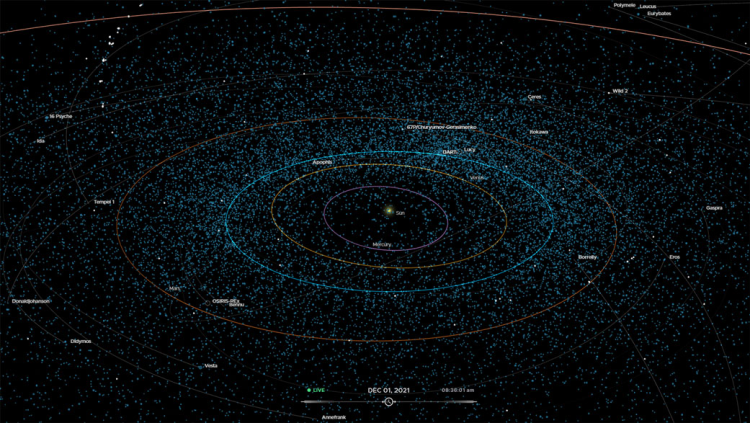
Artist's depiction of a near-Earth asteroid orbiting the sun. (Credit: DOE/FNAL/DECam/CTIO/NOIRLab/NSF/AURA/J. da Silva/Spaceengine)
Keep an eye on the skies.
Researchers from CU Boulder and NASA have completed a census of hundreds of large asteroids orbiting near Earth-gauging which ones could come precariously close to our planet over the next thousand years. The researchers identified at least 20 asteroids that scientists may want to study more to make certain they pose no threat to life on Earth in the next millennium.
To be clear, the researchers say the odds of any of these rocky bodies striking the planet are extremely low, and are next to zero for the coming century. But because the fallout from such an impact would be catastrophic, it's important to be sure, said Oscar Fuentes-Muñoz, lead author of the study.
"We don't want to alarm people, because the results are not alarming," said Fuentes-Muñoz, a doctoral student in the Ann and H.J. Smead Department of Aerospace Engineering Sciences. "But there are a lot of uncertainties in predicting so far into the future."
Click to enlarge
Visualization showing the locations of hundreds of near-Earth asteroids. (Credit: NASA/JPL-Caltech)
Click to enlarge
The asteroid Didymos, bottom left, and its "moonlet" Dimorphos, center, seen just minutes before NASA's Double Asteroid Redirection Test (DART) spacecraft intentionally crashed into Dimorphos-part of an experiment to change the orbits of both bodies. (Credit: NASA/Johns Hopkins APL)
He and his colleagues will publish their findings in an upcoming issue of The Astronomical Journal.
The study takes an unprecedented look at Earth's place in the solar system, which is surprisingly crowded. Scientists suspect that roughly 962 (plus or minus 50) asteroids a kilometer wide or even larger swing by our planet on a periodic basis. For reference, the asteroid that killed off the dinosaurs measured an estimated 6 miles (9.7 kilometers) across.
To find out which ones could get a little too close for comfort, the researchers used a set of innovative mathematical tools to predict the paths 851 large asteroids might take in the next millennium. Most seemed to keep a safe distance from Earth, but a few were less predictable. The orbit of one asteroid called 7482 (1994 PC1), for example, appeared to overlap a lot with Earth's orbit in the coming centuries. This one, Fuentes-Muñoz said, is worth keeping an eye on.
"The main finding of our study is homework," he said. "We want to get more information about a number of these asteroids so that we can completely rule out any impact risk in the next thousand years."
Fender bender
He added that humanity exists in a unique point in its history. Unlike the dinosaurs, humans have the technology to spot a lot of the big objects that pass by our planet. But like the dinosaurs, there's not much we can do about them. Still, the sooner we learn about potentially dangerous asteroids, the better, Fuentes-Muñoz said.
"Making a small deflection decades in advance is way more powerful than trying to deflect an asteroid a few years or months in advance."
Predicting where an asteroid will be hundreds of years into the future, however, gets tricky. A number of factors, from the pull of Venus' gravity to heat from the sun, nudge asteroids in their orbits, and those minor changes can add up over time. Fuentes-Muñoz and his colleagues wanted to see if they could narrow down those uncertainties. The team included David Farnocchia and Ryan Park of NASA's Jet Propulsion Laboratory in California and Daniel Scheeres, distinguished professor of aerospace engineering sciences at CU Boulder.
Fuentes-Muñoz explained that you can think about an asteroid impact like a traffic collision.
For two cars to crash, they first have to be traveling through the same intersection. They also have to reach that intersection at the exact same time.
In the new study, the researchers used a series of computer simulations to identify when the orbits of near-Earth asteroids might overlap with our own path around the sun-what scientists call the minimum orbit intersection distance (MOID). They then tried to identify the asteroids with timings that remain hard to predict. In other words, is there a possibility, even a small one, that these bodies could be in the same place and the same time as Earth?
7482 (1994 PC1)
In what might seem like good news for people, the list of candidates that could meet both criteria for an impact seems to be short. But, the researchers reported, a few asteroids stand out.
7482 (1994 PC1) is among them. This rocky body was first seen in 1974 and stretches about two-thirds of a mile from end to end. Most of the asteroids the team studied will likely cross Earth's orbit for only short windows of time-passing through briefly, then zipping away. 7482 (1994 PC1), however, could remain in Earth's close vicinity for most of the coming millennium.
Don't worry yet, Fuentes-Muñoz said: "We need more information to rule out an impact, but we still think it's unlikely to happen."
He added that the more information scientists gather about asteroids like this one, the more certain they can be about just how likely a collision could be in humanity's future.
"When I tell people about my research, the most common thing I get is, 'Will you let us know if something's going to happen?'" Fuentes-Muñoz said. "'Yeah, I'll let you know.'"








